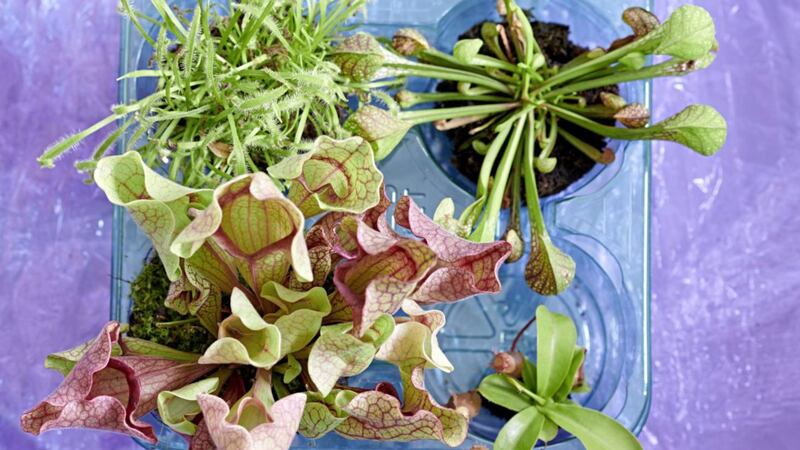IT BRINGS a whole new twist to the ‘Waiter, there’s fly in my soup’ joke but over recent years scientists have been exploring the potential of adding insects to the human diet as a cheaper, more environmentally friendly alternative to mammal and poultry meat. They’ve taken their lead from carnivorous plants which have long utilised the nutritious value of various insects.
While typically we would associate carnivorous plants with tropical regions, there are in fact 10 natives living in the wild across Ireland – for the time being at least. They generally inhabit boglands, those marginal places fashioned by nature over centuries where the ericaceous earth holds few nutrients. Sustenance, and nitrogen in particular, must be found elsewhere and its substitute is not drawn up through the roots but instead ingested from the carcasses of dead insects.
Various species of sundew, butterwort and bladderwort can be found across the island to a greater and lesser degree, while pitcher plants from North America thrive in the bogs of Co Roscommon, having been introduced more than a century ago.
They’re not necessarily the first thing that springs to mind when we want a bit of exotic plant life for the house or garden but carnivorous plants will bring a whole new dimension to your enjoyment of gardening. They’ll prove especially popular with children – of all ages – their insect-eating behaviour imbuing them with a menace we rarely associate with plants.
The best-known carnivorous plants are the Venus flytrap (Dionaea muscipula), sundew (Drosera), Sarracenia and Nepenthes.
The Venus flytrap is probably the most spectacular of the group. The leaves of this carnivore consist of two hinged jaws that slam shut, the closing mechanism triggered by contact from an insect or small spider. The plant is not easily fooled, however, and to be sure that the prey is present, they must touch the six sensor hairs on the leaf twice. If they're touched once, the leaves don’t snap shut.
Sarracenia and Nepenthes are both known as pitcher plants and employ the same method to catch prey. They take their common name from the long, deep receptacle that can range in length from a few centimetres up to more than 30cm. The ‘pitchers’ are distorted leaves that have nectar on the lips to attract insects. The prey is lured deeper inside before the unlucky ones find themselves free-falling down a wax slide into the bowels of the plant, where their desperate struggle activates glands inside the pitcher, prompting the release enzymes. Over a couple of days, the insect is digested leaving only a casing behind.
Drosera (sundew) form perfect rosettes on the ground and are equipped with red tentacles with a sticky, glistening drip at the end. This gives the flower its common name. Its prey gets stuck in the drip and is pushed by the agile tentacles towards the leaf surface, where it is digested.
Generally, gardeners will opt for indoor varieties but be mindful of their natural habitat and ensure they get lots of sun and are kept damp. They prefer to drink rainwater, or distilled or soft tap water. If you live in an area with hard water, boil it and leave to cool before serving.
For environmentally conscientious gardeners, providing the appropriate growing medium that replicates the optimum growing conditions in the wild – ie peat – will present a dilemma but rest assured there are solutions.
Most carnivorous plants are herbaceous so their traps will wither over winter only to re-emerge in the spring and as they catch their own meals they never need feeding.








